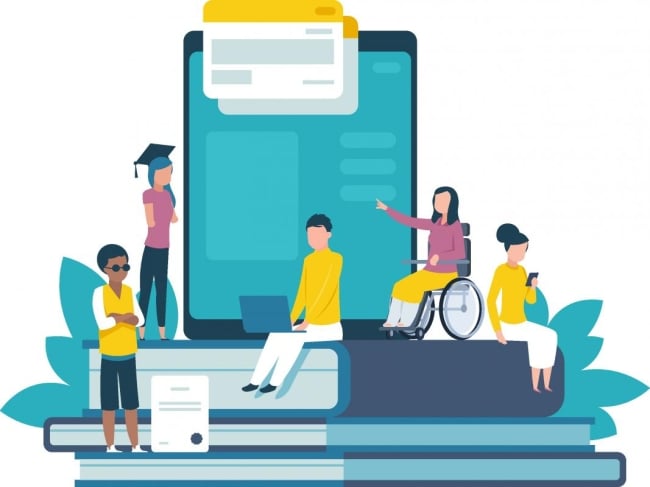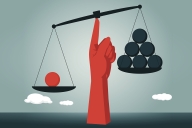You have /5 articles left.
Sign up for a free account or log in.

Spicy Truffel/istock/getty images plus
I’m a chemo-brained, hard-of-hearing leg amputee with Crohn’s disease and the never-ending buzz of tinnitus. I don’t necessarily announce all these things on the very first day of class. But in my syllabus accessibility statement, I state: disability rights are civil rights, some of my heroes were/are disabled rights activists, I am multiply disabled and use accommodations on the job, and I want students to tell me what they need to best participate in class, too.
Disability disclosure in the classroom is tricky, even if you have a disability that is relatively common and accepted. And if you have a disability type that is stigmatized or have other aspects of identity that come into interplay with student expectations and biases, disclosure can be an especially rocky road. Some of us are already more likely to be doubted and questioned in a classroom, as reflected in things like student evaluations, which are well-known to reflect certain biases.
I recently had a conversation with a Ph.D. student in a different program who is deliberating whether to disclose a nonapparent disability when she teaches; she’s working on a paper about it for a class. While we are both visibly disabled people -- recognizably disabled to students when we enter classrooms, we also have nonapparent disabilities. So while we both don’t have to disclose the obvious (that we are disabled), our obvious disabilities don’t reveal the larger picture.
I’ve come to find it important, as someone with an apparent disability, to let others know I have nonapparent disabilities, as well. Ableist expectations set people up to think of apparent disabilities -- especially around mobility, with paralyzed wheelchair users and amputees like me -- as more real, more valid or more solid. I don’t want my disabled students to feel as if I will dismiss their own disability statuses because they worry I think my apparent disability status is somehow more real.
Especially as an amputee, I recognize how images and stories about amputees -- particularly those who have lost limbs in war -- often influence how people read my body. We know, from disability studies, that amputee vets after the Civil War were the main beneficiaries of disability payments, to the neglect of veterans with other wounds and psychological trauma. Amputees’ bodies through the various wars were also used in messaging about both the horrors of war and about the valor and sacrifice of those in the armed services. Seen in fancy running blades, contemporary amputees are often read as heroic overcomers.
I am not these things; most of us aren’t. It presses me all the harder to talk about what people cannot see and to navigate my own experiences in ways that resist feeding narratives about bravery, on one hand, or about being pitiable, on the other.
My current approach is to mention that I am multiply disabled on the first or second day of class (whenever we talk about the syllabus) but to not elaborate until different disabilities become relevant. I may mention that I have a hard time hearing and for people to speak up if we’re in a large classroom where sound gets lost once we get into discussion. I may warn folks that I am having a Crohn’s flare, so I will be sitting down through our class on a particular day because my body is exhausted. I don’t usually plan my disclosures ahead.
What I’ve found in this approach is that students also open themselves up to talking about their disabilities, when it is relevant, without shame. I teach classes in science and technology studies, medical humanities, and philosophy of technology, as well as a class on technology and disability, so I try to leave room for each disabled student to claim their whole self and bring it to class -- articulating disabled expertise as a type of situated knowledge. Disabled people know things about infrastructure, adaptation and unstated norms that most people don’t recognize. The number of students who “come out” during a given semester always makes me feel joyful: we can be disabled together.
Students also then have the door open to making their work reflect their interests and identity. I’ve received wonderful student projects, such as a guide to sensory-related disabilities with ideas about stim tools/toys, a comic book about how brains work by a neuroscience student with a brain injury, surveys of places on campus relevant to particular types of disability, amazing poetry, incredible research projects where students come to know more about their own disability community and more. It’s made end-of-semester grading feel like a celebration.
Many times, students are in the midst of realizing they are disabled or coming to understand it as an identity -- and not something to fight against or hide. I try to meet accommodation requests with “thank you” and “Oh, good, this is helpful” -- and sometimes excitement at having other disabled people in the room. Often students with accommodation letters have already been met with questions, frowns and distrust when they have requested their accommodations in the past. I want to show trust -- of them and of myself as a disabled person -- in our interactions.
Inviting Opportunities
My disability disclosure has benefits for nondisabled students, who are put in the position of having an unashamed disabled professor. They also read work from other disabled scholars showing disabled people as competent and having much to add to various conversations. I was fortunate to know disabled scholarship and have disabled friends before I became disabled. It eased the transition for me in so many ways. I had a sense that being disabled would be OK because I knew others for whom being disabled was OK, even if the adjustment for me was difficult. I knew whom I could reach out to.
Most people will be disabled at some point: I know this gets thrown around, and sometimes in ways that suggest that’s why people should care about disability. But there’s more here. I want to be ready to welcome new members to the disability community because I have been so lucky to benefit from such a reception. Too often, people are only exposed to disabled people as objects of pity, inspiration or medical curiosity through fundraising campaigns or service projects. Being a person’s professor makes me none of those things.
While disclosure can be risky, I think about the risks in the other direction, too: by hiding parts of experience and knowledge, by shutting down avenues of consideration and understanding, and by not making space for community. Disclosure invites opportunities for humanistic learning and community building.
I would never fault a fellow colleague for not disclosing, or for waiting until they are more comfortable to do so, since the risks can be real. Disclosure can cause some of your colleagues to doubt your capabilities or students to be biased against you in evaluations. It can expose you to being shamed or stigmatized.
But disability disclosure can also be powerful for students. And it can be empowering for the one disclosing in sloughing off stigma, because -- in the words of the late writer, poet and disability rights activist Laura Hersey -- you get proud by practicing.








